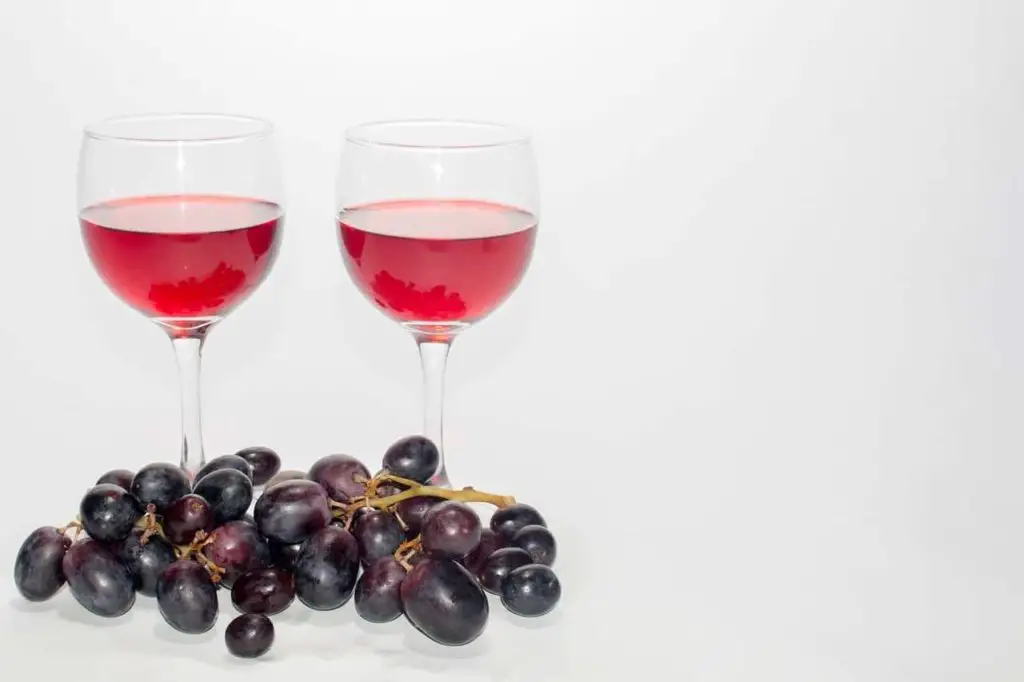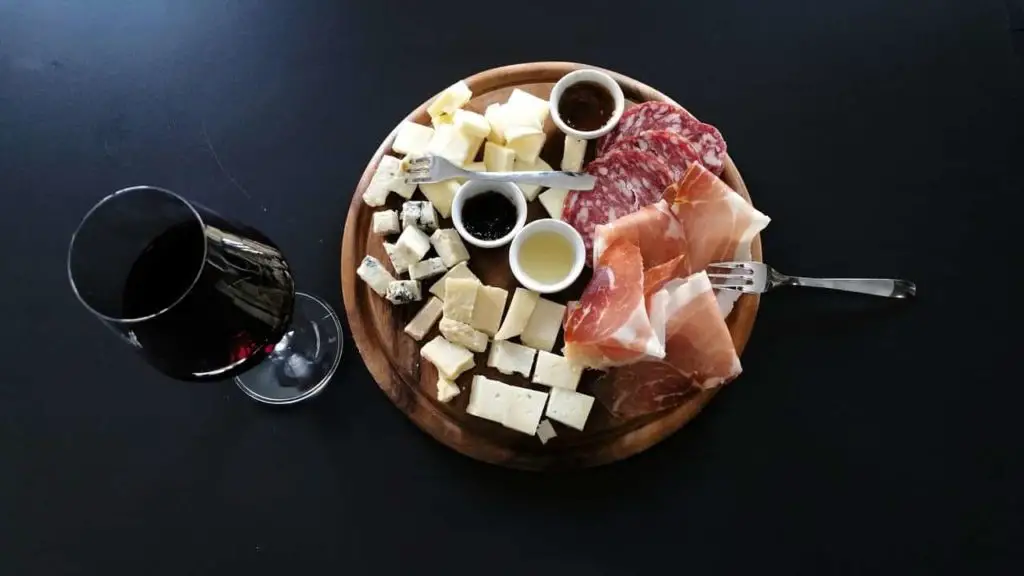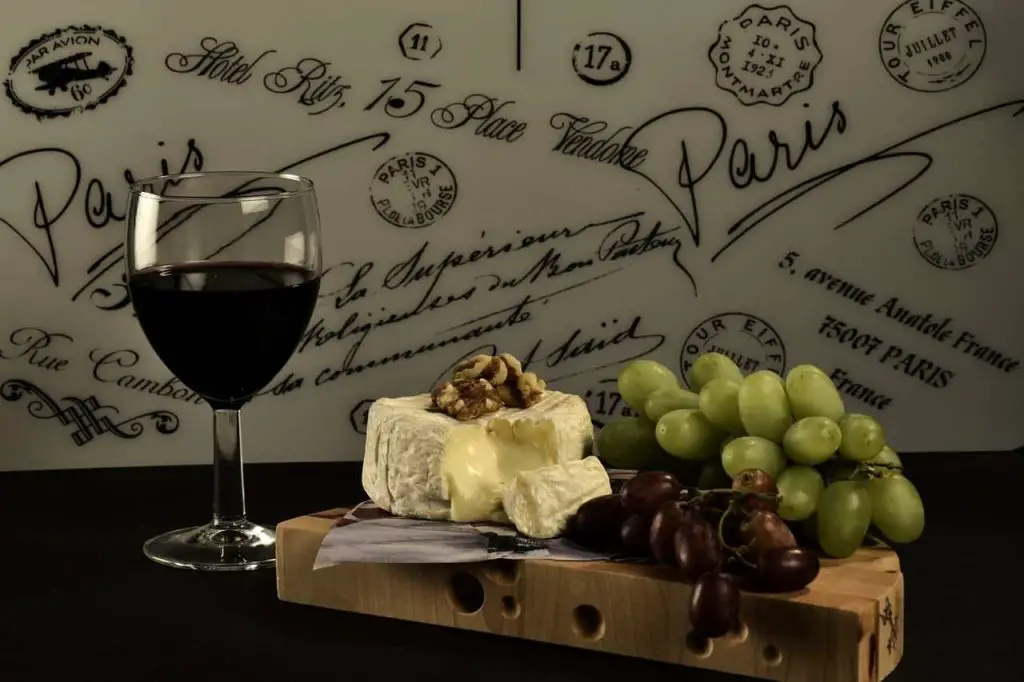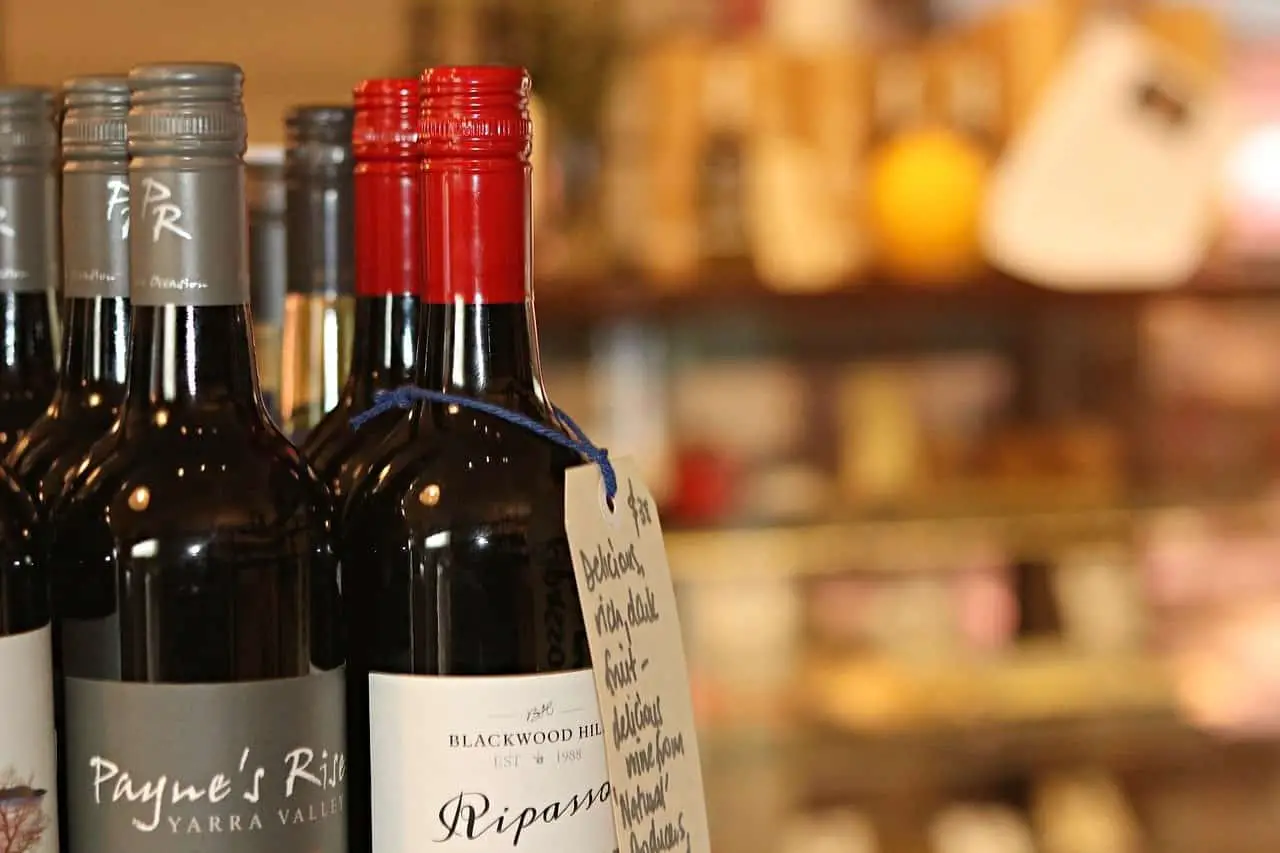Wine is perhaps the most classic drink of all. However, there are so many varieties of it that it can be quite difficult for beginners to orient themselves in the world of wine, at least in the beginning. Don’t know where to start? This guide is for you. And even if you know your way around wine, you might find out something useful.
Today, we focus on two global favourites: Merlot and Shiraz. These two wines are similar in colour which is luscious deep red in both cases, but they are actually quite different. Keep reading if you are interested to find out more.
Main Differences Between Merlot vs Shiraz
- Shiraz is a full-bodied wine with a robust flavour profile, while Merlot is more gentle being a medium-bodied wine.
- Merlot has a moderately sweet flavour reminiscent of fruit while Shiraz is more spicy and intense.
- When it comes to alcohol content, Merlot wines usually stay close to 14 per cent while Shiraz can contain anywhere between 10 and 15 per cent of alcohol, although it’s usually on the stronger side.
A Little More About Choosing Reds
Red wine is definitely one of the healthiest drinks. There is more and more evidence that suggests that when taken in moderation, this crimson liquid can be good for your heart and for the overall well-being. Not only this, but red wine is a drink suitable for almost any occasion. It can go well with lunch, dinner, and dessert. A good glass of red is a great choice for a romantic date but also perfect for a casual (or formal) gathering with friends. But how does one know which wine to choose?
There is no simple answer to this question – choosing your wine is quite a personal decision, and it is something that is learned with experience. However, one good reference point could be the tannin levels. Tannins are what gives the colour to red wine, but they also induce a certain level of bitterness. Wines that contain high levels of tannins also typically age quite well as tannins also act as natural preservatives.
You might be surprised to know that both red and white grapes contain tannins, but the levels are higher in red grape varieties. To complicate things further, red wine can actually be made of both red and white grapes (although it must contain at least some red grapes to give it the colour).
Today, we’ll be talking about Merlot and Shiraz specifically, so we should focus on that. Both of these sorts come from fairly dark grapes, but Shiraz (often called Syrah – it is the same sort) is much richer in tannins, which gives it a distinctly dark colour and a robust flavour. While Merlot is not a low-tannin wine, the contents are significantly lower than in Shiraz which makes it more suitable for beginners and more likeable overall.
Merlot

Merlot is one of the most popular and beloved red wines across the world. It is a dry, medium-bodied red, but one that is not excessively bitter like some other dry wines. The name of this wine comes, as expected, from French and it means ‘little blackbird’. The name most likely comes from the colour of both the wine and the grapes it is made from which is quite dark. The alcohol content of Merlot wine is usually between 13.5 and 14.5 per cent, but this is not a hard and fast rule – it primarily depends on the region the grapes come from.
Origin and History
Merlot comes from France, specifically the Bordeaux region where it has been cultivated at least since the 18th century. Today, it is one of the most well-known and most commonly cultivated grape varieties. The Merlot grape is soft and flavourful. The body of the grape is often described as ‘fleshy’. The skin of the grape is rather delicate and has a charming hue of dark blue. Due to the thin skiing, Merlo also ripens quite early.
These days Merlot is a favourite on its own, but it wasn’t always the case. During its early days in France, Merlot was mostly used in combination with Cabernet Sauvignon. This is indeed a great combination, as delicate Merlot softens the boldness of Cabernet Sauvignon caused by high tannin contents. However, today Merlot is also greatly appreciated on its own.
The production of Merlot is anything but restricted to France. Merlot can grow and ripen well in a variety of climates (as it ripens relatively early and therefore needs less sun coverage) which is why there are Merlot-growing regions on literally every continent. In Europe, it spread from France to Italy, to almost anywhere else Including Switzerland, Spain, Portugal, Romania, and even the Balkans. In the United States it is Grown in California as well as New York and Washington, but it can also be found in South America. Last but not least, Merlot grown in South Africa and New Zealand has produced some really great wines too.
In fact, the reputation of Merlot in Australia and New Zealand is steadily increasing in recent years as it seems to thrive in the climate. In New Zealand, regions like Marlborough, Martinborough, and Hawke’s Bay are big on Merlot these days. In Australia, Merlot is one of the most planted grape varieties in regions like Barossa Valley and Wrattonbully.
Flavour Profile and Character
While the taste of Merlot is often characterized as sweet, it is not sweet in the same way sugar is. The sweetness comes from the rich, fruity notes of the Merlot grape, but the actual sugar content of Merlot remains on the low side of the spectrum – it is definitely a dry wine.
Merlot is definitely a light, playful, easy-drinking wine. Merlot grapes are low in tannins but full of flavour, creating a product that is not bland, but also not overpowering. It is the perfect wine for beginners who are only starting to get acquainted with the distinct notes of red wine. You really can’t go wrong with it.
Wines made from Merlot can be medium-bodied or full-bodied. This actually depends on the style of the wine-maker – Merlot that is harvested earlier is a bit more acidic than fully-ripened Merlot grapes. As a result, Merlot can have notes reminiscent of raspberries, strawberries, or rhubarb, but some Merlot wines also summon heavier notes of blackberry, plum, chocolate, or cedar. Sometimes herbal notes like mint, oregano, thyme, and even tobacco are associated with Merlot too.
Overall, a sip of Merlot is gentle and smooth but can also be described as rich and velvety. It’s a wine with character, but not one that’s overpowering.
Merlot Pairing

Merlot is a very versatile wine. You can pair it with appetizers, with some classic dinners, and it also goes great with a variety of snacks. This wine really doesn’t need an extra special meal to bring out the best of it. It will go great with pizza, a plate of spaghetti Bolognese or lasagne, as well as all sorts of meat dishes. It works especially well with chicken or duck meat, for example, but that is definitely not a rule – it can pair just as well with a steak. If you are vegetarian though, don’t worry – Merlot will also pair well with the flavour of mushrooms, various herbs as well as nuts. And if you are looking for something sweet, try pairing a good bottle of Merlot with some quality dark chocolate
When choosing Merlot, it’s worth paying attention to the region of origin. Merlot that comes from regions with colder climate will generally be softer as well as a bit more acidic. These tend to go great with green vegetables and even salmon or prawns, although seafood and Merlot are usually not the best pair.
As you can see, there are plenty of options when it comes to food that goes well with Merlot, but there are still some combinations that are not recommended. Blue cheeses, for example, are not a good pair for Merlot, as they can easily overpower the subtle notes of this delicate wine. It is also not recommended to mix Merlot with overly spicy foods. Most spicy foods contain capsaicin which can make Merlot appear much more bitter than it really is.
That being said, rules are made to be broken. Feel free to experiment and find the combinations that work best for you!
The ideal serving temperature for Merlot is 17 degrees Celsius.
Shiraz

Shiraz is a wine that has gained in popularity immensely in the recent years. This dark, full-bodied wine has a unique flavour that really makes a statement. It’s rich in tannins and has a really complex flavour with spicy and fruity notes.
Origin and History
Let’s get one thing out of the way first. You might be wondering – what is the difference between Syrah and Shiraz? There is no difference. Syrah is the French name for the same grape variety. As the Syrah became popular in Australia, the name somehow switched to Shiraz. Historically, this name actually referred to wine coming from the city of Shiraz, a city in Iran. However, today you are much more likely to find Syrah wine under the name of Shiraz, and it has very little to do with Iran or ancient Persia.
So where does Syrah come from? There is no definite answer to this question, but it seems to be the Rhône region in France. At the very least, this grape variety has been grown in the region for a very long time, and recent research shows that Syrah is the offspring of two older varieties – Dureza and Mondeuse blanche.
In any case, Syrah is a very unique grape. It is juicy, full-flavoured, and has a very thick skin. It takes a relatively long time to ripen fully, but the result is amazing. The way Syrah is harvested is also somewhat unique. Once picked off the vine, the grapes are soaked in cold water for anywhere from a couple of days to a month or more. This is called cold-soaking and the purpose of the process is to amplify the sweet and mellow berry notes in the grape while moderating the bitterness caused by tannins.
Syrah was one of the first wines that was brought to Australia in the 18th century – and it came to be extremely popular there. Some would even say that Australian Shiraz is among the best in the world. One thing to know about Shiraz is that the flavour and bouquet of the wine can be really different depending on the region it comes from. We’ll talk more about that in the next section!
Flavour Profile and Character
The taste of good Shiraz is something anyone should try at least once! The flavour is bold but also rather sophisticated. You can expect to taste deep fruity notes of blackberries combined with spicy notes of pepper, truffle, eucalyptus or clove. Earthy tones of leather and coffee are also possible.
As we mentioned, the flavour profile of Syrah wine depends on the region where it was produced. Syrah grapes with Sicilian and Greek origins usually create a unique-tasting wine full of earthy flavours, while Australian Shiraz really brings out the spiciness of this variety and really dark, fruity flavours. Typically, grapes that were grown in more Northern regions will give a more spicy flavour profile.
Shiraz Pairing

Shiraz is a great pairing for spicy food and all sorts of strong flavours. It can pair well with various dishes from across the world, including bold Indian and Thai dishes. Pairing strong and spicy flavours with red wine can be difficult, because the taste can overpower the wine and make it appear bland or bitter. However, this will not happen with Shiraz. The deep spiciness of Shiraz will rather complement the food.
That is not to say that you need overly spicy food to find a good pair for Shiraz – it can really be consumed with almost any food. Pulled pork or any kind of slow-roasted meat are a great choice, but also is ratatouille, barbecued anything, or a spicy stir-fry-type dish.
The ideal serving temperature for Shiraz is between 16 and 18 degrees Celsius.
A Bottle of Merlot vs Shiraz

So what is really the difference between these two sorts? The Syrah vs Merlot comparison is analogous to masculine vs feminine. Shiraz is a wine with a strong bouquet and very distinct notes. It’s confident, it’s spicy, it really makes a statement. On the other hand, Merlot is delicate, playful, and lady-like. It mixes fruity and floral notes to create a taste that is sweet but not too sweet – and it goes well with almost any type of food. While they are both fairly dark in terms of colour, Shiraz is actually quite a bit darker than Merlot, and it contains more tannins. This can make it taste too bitter to palates that are not used to this flavour. Merlot, on the other hand, is soft, friendly, and easy to love.
The Health Benefits of Red Wine
We’re often told that one glass of wine a day keeps the doctor away. Considering that wine has a long history of use as a medicine, that’s no surprise. In fact, according to 4,000 years old Sumerian tablets, wine is the oldest documented man-made medicine.
But can an alcoholic drink really be a remedy? Scientists have been trying to prove this claim for decades now and there are over 1,000 papers written on this matter. Although this rejuvenating reputation is yet to be proven, it’s believed that moderate drinking of red wine has different health benefits.
So what made them think red wine is good for our physical wellbeing? Well, grape skin and seeds are rich in different compounds like resveratrol, epicatechin, catechin, and proanthocyanidins. These things are beneficial to our body in multiple ways.
Here are different reasons why red wine is good for us.
It Helps in Boosting Up Good Cholesterol

There are two kinds of cholesterol – High-density lipoprotein (HDL) and low-density lipoprotein (LDL). The HDL is considered “good” since it transports cholesterol to your liver, where it’s removed from your body. That means that it doesn’t end up in your blood system. LDL, on the other hand, deposits cholesterol in arteries, and eventually can cause a heart attack or a stroke.
A high level of good cholesterol lowers the risk of heart diseases, and wine can help with that. A study conducted by Clinical Nutrition that moderate consumption of red wine increases levels of HDL. This is thanks to resveratrol, which is a substance plants produce when attacked by bacteria or fungi.
It Combats Depression
All those people that opt for a glass of wine to deal with a tough day can’t be wrong. In fact, a study by PREDIMED proves just that. This research monitored 5,500 individuals over a period of seven years. No participants had a history of alcohol-related problems or depression prior to the study. This research showed that those who drink two to seven glasses of red wine per week are less likely to be depressed than those who don’t.
However, drinking too much can cause the opposite effect. Enjoying more than eight glasses of wine can easily lead up to addiction and chronic depression. If your main reason for drinking wine is comparing this mental condition, don’t do it at all.
Red Wine Helps in Reducing Heart Disease Risk
Did you know that cardiovascular disease is the most common cause of mortality in the world? As much as 31% of deaths are caused by heart problems. However, it seems that this is not true when it comes to French. Heart disease mortality is low in France, and we all know French are known for enjoying a good glass of red wine. Are these things connected? Many studies agree.
Red wine is rich in polyphenols which help our hearts in several ways. They improve the function of blood vessels and the inner lining of the heart, as well as help with cholesterol absorption. They also have anti-inflammatory and antioxidant properties. Plus, since it helps you regulate cholesterol levels, it prevents blood clots from forming.
Red wine can also increase the level of omega-3 fatty acids in the blood. These fats lower triglycerides, and that way they protect us from stroke and other heart diseases.
However, that doesn’t mean you should start drinking just to prevent possible heart issues. Alcohol consumption is addictive, and drinking too much will do more harm than good.
It Slows Down the Decline of the Human Brain
Tasting wine for a living? Sounds easy, but it’s far from it. Sommeliers have to use their eyes, nose and mouth to analyze the wine they’re drinking. But even if you’re just an enjoyer of good wine, you’re using all of your taste and odour receptors. As a result, you’re engaging your mind more than any other activity would. Yes, more than removing a thorn from your foot or solving an applied mathematics problem.
Your brain does some serious work there, involving your cognition, memory, emotion and pleasure systems. That’s because our brains are what creates the sensory world. Remember that viral photo of a dress, when people argued whether the dress was black and blue, or white and gold? Scientists explained that these differences in opinion resulted from how we perceive colours. Well, the same goes for taste and smell, too.
Therefore drinking wine is like yoga for the brain. Engaging all senses helps you stay mentally sharp. But, wine benefits on our brains don’t stop there.
Resveratrol helps with the prevention of the formation of Amyloid Beta proteins in the brain. This protein naturally builds up in our brains as we grow old, however, abnormal levels lead up to plaques. These plaques disrupt brain cell function and can cause Alzheimer’s disease. Resveratrol helps by keeping the blood vessels open and flexible. That way, both glucose and oxygen can travel smoothly to the brain and keep it sharp.

There’s a study that claims resveratrol can extend the lifespan. Our bodies contain a gene that protects us from ageing-associated diseases. In this study, resveratrol was used to activate this gene, and it turns out it can increase lifespan by 60%! Truth be told, tests were only done on worms, but scientists are optimistic human cells can be affected the same way.
Other health benefits of drinking red wine regularly include:
Prevention of Cavities
Anthocyanins, a pigment responsible for wine’s red colour, can stain your teeth. With that in mind, taking a photo right after pouring down a glass of wine might not be the best idea. Especially if you’re using flash. However, that doesn’t mean that red wine is bad for our teeth. It’s quite the opposite.
Science says that over 91% of adults have had a cavity at some point in their lives. Cavities are holes in teeth created by bacteria in our mouths. When you mix food remains, germs and saliva, you’re left with a plaque that destroys your tooth enamel.
Here’s how wine can help with oral hygiene. All the antioxidants found in red wine prevent this bacteria from sticking to our teeth and gums, thus preventing the creation of plaque. No plaque means no cavity. It’s a win-win situation.
It Helps in Combatting Damage by Free Radicals
Free radicals are atoms or molecules with an uneven number of electrons. This imbalance makes them search for another molecule to connect to. This causes an unstable chemical reaction which is called oxidation. When this becomes a chain reaction, it stresses your body. Free radicals break down cells over time, and sooner or later, your body loses the ability to fight them. As a result, you’re prone to different diseases.
Here’s an example. Sugar isn’t bad for our body. That is, unless we consume too much of it. If you’re eating 10 doughnuts every day, there’s a high chance of getting diabetes somewhere in the future. Well, diabetes is caused by a long exposure of your body to free radicals that are created by the excess of sugar in your system.
Eating that many doughnuts a day is our choice, but there are sources of free radicals in the environment we’re all unwillingly exposed to. Radiation, pollution and pesticides are just some of those sources that put your body under oxidative stress. Even if you decide to live on a lone island somewhere in the middle of the Pacific, you’re going to be exposed to the greenhouse gases created by a damaged ozone layer.
While you can’t avoid oxidative stress completely, there are ways to minimize its effect on the body. To do this, you can implement antioxidant food and supplements to your regime. Antioxidants are molecules that connect to free radicals and calm them down. Let’s just say they make a balance by protecting your body from oxidative stress.
How is this relevant? Well, red wine is abundant in antioxidants. When consumed in a moderate amount, it stabilises chemical reactions in your body and strengthens your immune system. Resveratrol is potent enough to prevent DNA damage and suppress the possibility of tumour cell creation and progression.

This doesn’t mean that wine will magically keep you safe from cancer, cardiovascular or neurodegenerative diseases, but it makes you a strong fighter against them.
Red Wine Promotes Liver Health
Excess drinking damages the liver, but moderate amounts can actually be beneficial. Red wine, in particular, can reduce the risk of liver fibrosis. With that being said, if you’re already suffering from a certain liver disease, you should avoid it without exception.
Red Wine Can Help in Curbing Your Allergies
According to recently conducted clinical trials, flavonoids found in red wine can reduce asthma and allergies. It can stabilize cells that produce histamine, which is a chemical that causes symptoms like a runny nose or sneezing.
However, this is yet to be scientifically proven and should be taken with a grain of salt. Furthermore, there are also people intolerant to grape, sulfites or other components found in this drink.
It Helps in Fighting Weight Gain and Obesity
Grapes are rich in piceatannol, which is a derivate of resveratrol. According to several pieces of research, this compound could be a way to prevent obesity. While this isn’t yet tested on humans, it sounds promising.
Here’s why. Piceatannol can slow down or even prevent adipogenesis, which is a process that turns baby fat cells into mature fat cells. Insulin stimulates this process, and piceatannol delays or even prevents that from happening. Mature fat cells store energy as fat, but if they never grow fully, they won’t be able to do that. As a result, all those cheeseburgers won’t stick to your waistline.
Reduces the Risk of Cataracts
Moderate consumption of red wine might be helpful in preventing cataracts. This is, once again, thanks to resveratrol and flavonoids found in grapes. A cataract is yet another condition that can develop as a result of oxidative stress. As we already know, antioxidants can prevent that.
Resveratrol boosts glutathione, which is an antioxidant that keeps aqueous humour clean. Aqueous humour is the fluid our eyes produce that keeps eyeballs wet and healthy. It also helps with regulating eye pressure. Our eyes already produce this compound, but the level decreases over time and when exposed to free radicals. By drinking red wine, we intake this antioxidant that not only reduces the chance of cataracts, but glaucoma, retinal disorders and diabetic blindness as well.
Red Wine Helps in Preventing Stroke and High Blood Pressure
Our bodies are like machines. They consist of different types of tissue, all of which have a specialized function. However, they all work together to maintain the life and health of our organisms. Through this system, every piece of our body is connected. That’s why, for instance, a toothache can cause ear pain and even heart problems.
We mentioned that polyphenols improve the function of blood vessels and cholesterol absorption. When bad cholesterol builds up inside the arteries, it narrows down the vessel and makes it hard for blood to go through. The thinner the arteries are, the more a heart has to pump to push the blood flow. That, in turn, causes high blood pressure, otherwise called hypertension, which can cause serious heart problems. By drinking wine, we’re treating our bodies with antioxidants that clear the arteries and help our heart work at its usual rate.

Let’s also not forget that high blood pressure can be caused by a lot of stress. Our fast-paced lives are filled with situations that push us to the edge, and it’s no surprise that hypertension is a common condition. People do different things to destress, and pouring down a glass of wine at the end of a long week is one of those things. It relaxes the nervous system and slows down your thought processes. This, in turn, lowers your blood pressure. Do you see how everything in our bodies is connected?
It Enhances Bone Strength
Another thing phytochemicals found in wine can benefit are bones. Our bodies need calcium to function properly, yet they can’t produce it. The way we provide the body with calcium is through our food intake. This mineral is stored in our bones, and when we don’t get enough of it from our diet, the body gathers it back from them. This weakens the bone and increases the possibility of fracture.
That’s where resveratrol jumps in. This compound improves bone density and stimulates the formation of bone cells. Trust us, your future self will thank you for enjoying a glass of red wine every now and then.
The Difference Between White Wine and Red Wine
If you’re only discovering the world of wine-sipping, one question naturally arises – what’s the difference between white and red wine? The most obvious one is the colour. White wine is made with white grapes, while red or black grapes are used for red wine. But there’s also a distinction on how they’re made. Both are made by juice fermentation, but red wine also contains grape skins and seeds. The skins are rich in tannin, a polyphenol that gives red wine that colour.
More often than not, red wine contains more alcohol than white wine. That’s because red grapes are richer in sugar than white, and the fermentation process turns sugar into alcohol. The reason why red grapes are sweeter is that they’re riper when picked than white grapes.

The quality of wine depends on the fermentation process, but also the geographical origin of grapes. Wine is produced all around the world, but soil and weather conditions in certain regions allow the vine to thrive more than in other parts of the world. Spain, Italy, Australia, France and Chile are regions that make wine of the highest quality.
Is It True That Red Wine is Healthier Than White Wine?
When it comes to health benefits, red wine surpasses white by a large margin. Grape skins, used in making red wine, are abundant in nutrients and antioxidants. White wine only uses grape juice, and therefore misses out on all those good things.
But even though our bodies can benefit from drinking red wine in several ways, alcohol consumption should never be used as a primary way of improving your health. Alcohol is addictive, and excessive use will do more harm than good. A classic saying “more is better” definitely is not true in this case. Drinking too much can lead to a large number of physical and mental health problems. Excessive alcohol intake is related to 2.8 million deaths annually.
Plus, most of the benefits mentioned in this article are yet to be scientifically proven. The majority of these studies were conducted by observational method, and shouldn’t be taken for granted.
When all that is said and done, there’s nothing wrong with enjoying a nice glass of wine every now and then. And if you want to pick the healthier of the two, red wine is your best bet. Just remember, do so in moderation.
FAQ: Frequently Asked Questions
Is Shiraz sweet?
No, Shiraz is actually the opposite of sweet. It is considered a dry wine. However, don’t let that put you off of trying a good bottle of Shiraz. Depending on the region, it can be quite dry, but this is not necessary.
Which wine is sweeter, Shiraz or Merlot?
Merlot is considered sweeter than Shiraz. However, don’t expect Merlot to be literally sweet either. The sweetness is more reflected in the fruity notes of its flavour. Shiraz, on the other hand, has a deeper more robust flavour and depending on the region it comes from it can have hints of sweetness.
Why is Shiraz called Shiraz?
Perhaps you have heard about the city of Shiraz in Persia. Hence, Shiraz should be Persian wine, right? Well, not really. The grape variety is called Syrah and recent research shows it almost certainly originated in France. However, manufacturers mainly from Australia and South Africa started calling the wine Shiraz. Today, the terms Syrah and Shiraz are practically equivalent.
The Final Sip: Shiraz vs Merlot
Slowly but surely, we’ve come to the end of our Syrah vs Merlot comparison. Hopefully, we’ve given you enough details to understand the difference between Syrah (or Shiraz) and Merlot. However, the only way to find out what you really like is to try both!
In all seriousness, both Shiraz and Merlot are excellent grape varieties and are perfect for special occasions. Merlot is generally better for beginners, as it has lower tannin levels, creating a softer, more delicate flavour which is still complex.
Shiraz is more of an acquired taste, but a good one at that. It is the perfect wine for entering the world of dry wines with bold flavour profiles. One occasion where Merlot doesn’t perform well is with spicy foods which can overpower the flavour of the wine. This, however, is the perfect occasion for Shiraz to step in.


